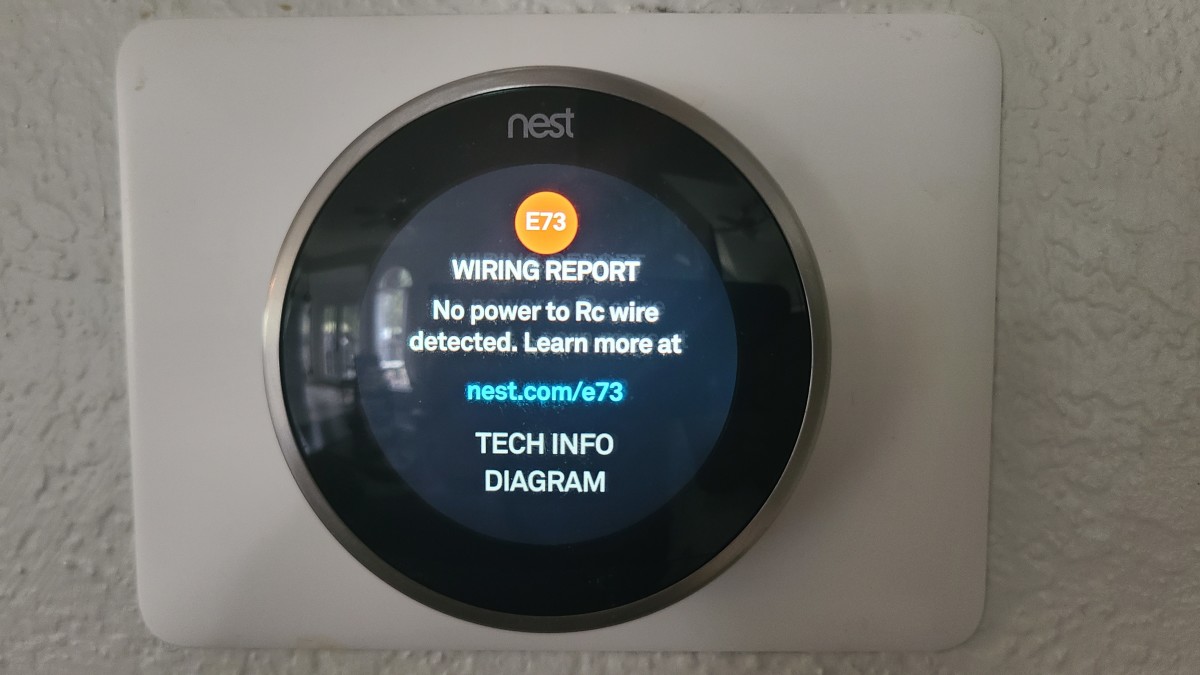Nest Thermostat Wires Not Detected: Quick Fixes!
If your Nest thermostat is not detecting wires, there may be a few possible reasons for this issue. One common cause is that the wires may not be properly connected or inserted into the thermostat’s base.
Another possibility is that the wires are damaged or broken. Additionally, if the wires are not labeled correctly, the thermostat may not be able to detect them. It’s important to check the wiring connections and ensure they are securely and correctly inserted.
If the problem persists, you may need to consult a professional technician to diagnose and resolve the issue.
Introduction To Nest Thermostat Wiring Issues
Nest thermostat wiring issues can lead to wires not detected errors, causing heating and cooling problems. Common symptoms of wiring problems include the thermostat not turning on, displaying mistakes, or not controlling the HVAC system properly. Proper wire detection is essential for the thermostat to function correctly and maintain a comfortable indoor environment.
When wires are not detected, the thermostat may not receive power or be unable to communicate with the heating and cooling system. This can result in issues such as the HVAC system not turning on or running continuously. It’s important to address wiring problems promptly to ensure the Nest thermostat operates efficiently and effectively.
Initial Troubleshooting Steps
Start by checking the power supply when troubleshooting Nest thermostat wires are not detected. Ensure that the thermostat is receiving power and the wires are properly connected. Inspect the thermostat display for any error messages or issues. If the power supply and connections seem fine, restart the thermostat and check for any firmware updates.
It’s also helpful to review the installation manual to verify the correct wiring setup. In some cases, resetting the thermostat to its default settings can resolve detection issues. If the problem persists, reaching out to Nest customer support or a professional technician can provide further assistance.
Understanding The Nest Wiring Setup
The Nest thermostat requires specific wires to be properly detected. Identifying the different wire types is crucial. The C-wire, or common wire, provides continuous power to the thermostat. The Rh and Rc wires are for heating and cooling. The Y-wire is for air conditioning, the W-wire is for heating, and the G-wire is for the fan.
Understanding the role of each wire in the system is essential for a successful Nest wiring setup.
Common Reasons For Wire Non-detection
One common reason for wire non-detection in Nest thermostats is loose connections. This issue can arise when the wires are not firmly connected to the thermostat terminals. Another reason could be compatibility problems between the thermostat and the HVAC system.
Checking for these issues can help troubleshoot wire non-detection problems.
| Common Reasons for Wire Non-Detection |
| If you have a Nest thermostat and it’s displaying an error message that says “Wires Not Detected”, don’t worry, there are some common reasons why this might be happening. |
| Loose or Corroded Connections |
| One reason for wire non-detection is loose or corroded connections. This can occur if the wires are not properly connected to the thermostat or if there is corrosion on the wires themselves. To fix this issue, make sure the wires are securely connected and clean any corrosion off the wires using a wire brush. |
| Incompatible System or Wiring |
| Another reason for wire non-detection is an incompatible system or wiring. This can occur if the Nest thermostat is not compatible with your HVAC system or if the wiring is not compatible with the Nest thermostat. To fix this issue, you may need to consult with an HVAC professional or check Nest’s website to ensure compatibility. |
Step-by-step Guide To Fixing Wiring Issues
It can be frustrating when your Nest thermostat wires are not detected. Luckily, there are steps you can take to fix wiring issues.
The first step is to secure any loose wires. Check each wire to make sure it is properly connected and tightened. If you find any loose wires, use a screwdriver to tighten the connections.
The second step is to address any corrosion or wear on the wires. Corrosion can cause poor connectivity, so it is important to clean any corroded wires with a wire brush or sandpaper. If the wires are worn, you may need to replace them.
By following these steps, you should be able to fix wiring issues with your Nest thermostat and get it up and running again.

Credit: dengarden.com
When To Reset Your Nest Thermostat
When your Nest thermostat wires are not detected, it’s time to perform a reset. But how do you know when it’s necessary to reset your thermostat? Generally, you should reset your Nest thermostat if you’re experiencing any issues with it, such as connection problems, malfunctioning sensors, or software glitches.
To perform a proper reset, follow these steps:
| Step 1: | Press and hold the Nest thermostat display for about 10 seconds. |
| Step 2: | Release the display when the screen goes black. |
| Step 3: | Wait for a few seconds, then press and hold the display again for about 10 seconds. |
| Step 4: | Release the display when the Nest logo appears. |
Performing a reset can impact wire detection, so it’s important to check your Nest’s wiring after a reset to ensure everything is properly connected. If you’re still experiencing issues after resetting your Nest thermostat, it may be time to contact a professional.
Professional Intervention Or Diy?
If your Nest thermostat is not detecting wires, you may be wondering if you should call in a professional or attempt to fix the issue yourself. Evaluating the complexity of the issue can help you make an informed decision.
If you have experience with electrical work and feel confident in your abilities, you may be able to troubleshoot the issue on your own. However, if you are unsure about the wiring or do not have experience with electrical work, it may be best to call a professional.
Attempting to fix the issue on your own could result in further complications or even damage to your thermostat or HVAC system. A professional can quickly diagnose and fix the issue, ensuring that your system is working correctly and efficiently.
Additionally, a professional can provide valuable advice and guidance on how to maintain and care for your Nest thermostat, helping to prevent future issues.
| Signs you may need professional help: | Signs you may be able to fix the issue yourself: |
|---|---|
| Unfamiliarity with electrical work | Experience with electrical work |
| Multiple wires not detected | Single wire not detected |
| Difficulty accessing thermostat wiring | Easy access to thermostat wiring |

Credit: www.reddit.com
Preventive Measures For Future
When dealing with Nest thermostat wires not detected issues, it is essential to take preventive measures for the future. Regular maintenance tips can help in preventing such problems. Upgrading your thermostat wires to higher-quality ones can also be beneficial. Regularly checking and cleaning the wires can ensure their proper functioning.
Additionally, scheduling professional maintenance checks can help in detecting any potential issues early on. Moreover, keeping the thermostat and its wires away from any interference or damage is crucial for their longevity and performance.
Conclusion: Ensuring Long-term Functionality
The Nest thermostat wires not detected issue can be resolved with simple troubleshooting steps. Ensure that the wires are properly connected and the thermostat is receiving power. Check for any loose connections and secure them if necessary. Recap the quick fixes such as resetting the thermostat and checking the wiring compatibility.
Proper thermostat maintenance is essential for its long-term functionality. Regularly clean the thermostat and inspect the wiring for any signs of damage. By following these steps, you can prevent the Nest thermostat wires not detecting problems and maintain the efficiency of your HVAC system.

Credit: www.reddit.com
Frequently Asked Questions
Why Are The Wires Not Detected On My Nest Thermostat?
If the wires are not detected on your Nest Thermostat, check if they are properly connected and securely inserted. Make sure the wires are not damaged or frayed. Restart the thermostat and ensure it is properly mounted. If the issue persists, contact Nest customer support for further assistance.
Why Is My Nest Power Connector Not Detected?
The Nest Power Connector may not be detected due to a few possible reasons. Firstly, ensure that the connector is properly plugged into both the power outlet and the Nest device. Additionally, check if the power outlet is functioning correctly and if the Nest device is receiving power.
If the issue persists, contact Nest customer support for further assistance.
Why Are My Thermostat Wires Not Getting Power?
Thermostat wires may not be getting power due to a tripped circuit breaker, a blown fuse, a faulty transformer, or loose connections. Check the breaker/fuse, replace if needed, and ensure all connections are tight. If the issue persists, consult a professional HVAC technician for further assistance.
Why Is My Nest Thermostat Not Detecting Y1?
Your Nest Thermostat may not be detecting y1 due to several reasons. Check if the y1 wire is properly connected to the thermostat and HVAC system. Ensure that the y1 terminal is correctly identified in the wiring configuration. If the issue persists, contact Nest support for further assistance.
Conclusion
To sum up, troubleshooting the issue of Nest thermostat wires not being detected can be a frustrating experience. However, by following the steps outlined in this blog post, you can effectively troubleshoot and resolve the problem. Remember to check the wiring connections, ensure compatibility, and consider professional help if needed.
By addressing these issues, you’ll be on your way to enjoying the full functionality of your Nest thermostat. Keep in mind that regular maintenance and updates can also help prevent future detection issues.
- Nest Thermostat Fan Always On: Quick Fixes & Tips - September 1, 2024
- How Much to Install a Nest Thermostat? Smart Savings! - August 31, 2024
- Reset Nest Thermostat for New Owner: Quick Setup Guide - August 30, 2024
